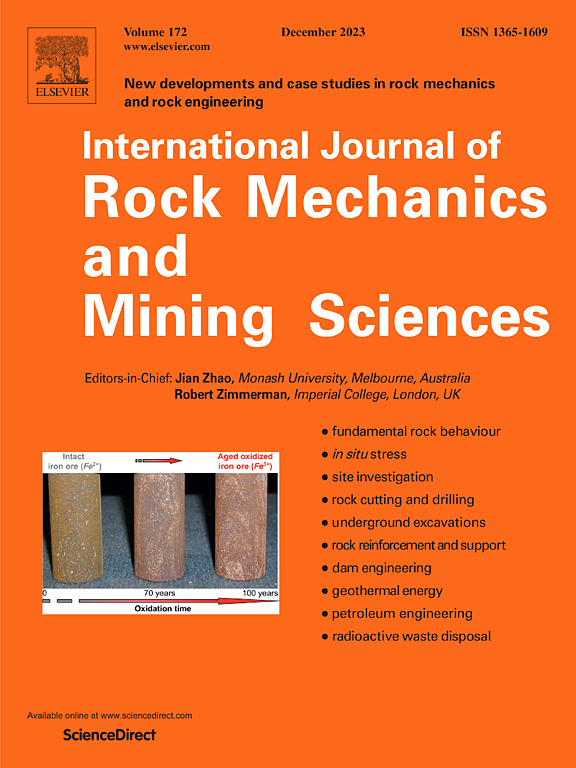Optimization of multiple hydraulic fracture initiation and propagation in deep tight reservoirs considering fracture macro/micro characteristics
IF 7
1区 工程技术
Q1 ENGINEERING, GEOLOGICAL
International Journal of Rock Mechanics and Mining Sciences
Pub Date : 2025-04-22
DOI:10.1016/j.ijrmms.2025.106126
引用次数: 0
Abstract
In deep reservoirs, high pressure and horizontal stress difference lead to elevated breakdown pressure and reduced stimulation efficiency during multi-cluster hydraulic fracturing. To address these challenges, we carry out experimental studies to reveal the effects of fluid viscosity and flow rate, perforation cluster density, and flow control methods on the initiation and propagation of hydraulic fractures. The RA-AF method and SEM (Scanning Electron Microscope) + EDS (Energy Dispersive Spectrometer) + XRD (X-ray Diffraction) analyses were employed to evaluate the micro-fracture characteristics, including morphology, fracture types, and surface roughness. The results indicate that adjusting the fluid viscosity and flow rate is difficult to improve the initiation efficiency of perforating clusters, but the optimization effect on a single perforating cluster is significant. Low viscosity and flow rate promote the formation of multiple shear fractures around the perforation cluster, while high viscosity and flow rate will form a single through fracture. Dense perforation clusters induce multi-cluster fracture initiation, but also raise the peak pump pressure. Compared to multi-cluster synchronous injection, innovative intelligent injection methods (multi-stage synchronous injection and multi-stage asynchronous injection) achieved 100 % perforation clusters initiation. Multi-stage synchronous injection led to the formation of multiple shear fractures in some clusters but was prone to fracture deviation due to the stress shadow effect. Multi-stage asynchronous injection was less affected by stress shadow but exhibited higher peak pump pressure throughout the fracturing process. The test results reveal that there is a certain correlation between pump pressure fluctuation and hydraulic fracture macro/micro characteristics. These findings provide valuable data and theoretical guidance for fracturing design in deep tight reservoirs.
考虑压裂宏观/微观特征,优化深层致密储层中多重水力压裂的启动和传播
在深层储层中,高压和水平应力差导致多簇水力压裂破裂压力升高,增产效率降低。为了应对这些挑战,我们开展了实验研究,揭示了流体粘度和流速、射孔簇密度和流量控制方法对水力裂缝起裂和扩展的影响。采用RA-AF法和SEM(扫描电子显微镜)+ EDS(能量色散光谱仪)+ XRD (x射线衍射)分析评价微断裂特征,包括形貌、断裂类型和表面粗糙度。结果表明,通过调节流体粘度和流量难以提高射孔簇的起射效率,但对单个射孔簇的优化效果显著。低粘度和低流量有利于射孔簇周围形成多条剪切裂缝,高粘度和高流量则会形成一条单一的贯通裂缝。密集的射孔簇会诱发多簇裂缝起裂,但也会提高泵的峰值压力。与多簇同步注入相比,创新的智能注入方法(多级同步注入和多级异步注入)实现了100%的射孔簇初始化。多段同步注入在某些簇中形成了多条剪切裂缝,但由于应力阴影效应,容易产生裂缝偏差。多级异步注入受应力阴影的影响较小,但在整个压裂过程中泵压力峰值较高。试验结果表明,泵压力波动与水力裂缝宏微观特征之间存在一定的相关性。这些发现为深部致密储层压裂设计提供了有价值的数据和理论指导。
本文章由计算机程序翻译,如有差异,请以英文原文为准。
求助全文
约1分钟内获得全文
求助全文
来源期刊
CiteScore
14.00
自引率
5.60%
发文量
196
审稿时长
18 weeks
期刊介绍:
The International Journal of Rock Mechanics and Mining Sciences focuses on original research, new developments, site measurements, and case studies within the fields of rock mechanics and rock engineering. Serving as an international platform, it showcases high-quality papers addressing rock mechanics and the application of its principles and techniques in mining and civil engineering projects situated on or within rock masses. These projects encompass a wide range, including slopes, open-pit mines, quarries, shafts, tunnels, caverns, underground mines, metro systems, dams, hydro-electric stations, geothermal energy, petroleum engineering, and radioactive waste disposal. The journal welcomes submissions on various topics, with particular interest in theoretical advancements, analytical and numerical methods, rock testing, site investigation, and case studies.

 求助内容:
求助内容: 应助结果提醒方式:
应助结果提醒方式:


